| |
'"Are you telling me he was difficult because he wanted his dressing room painted a certain shade of blue, or because he wanted to get the scene right?" "He wanted to get it right," she replied. So after that, I realised that the temperament came out of the perfectionism and not just random movie star behaviour.' |
| |
An American in Paris co-star Nina Foch interviewed by Robert
Trachtenberg on ‘difficult’ Gene Kelly’s approach to his work** |
There is a small moment in Singin' in the Rain that should be enshrined as filmmaking perfection. It features a mistake (a prop lands in an unfortunate place) but not only is that mistake rectified in a split second of an extemporaneous gesture, it's built upon with a brief eye roll that says "Why do these things have to happen to me?" The genius of the moment was not its execution (although all credit to Debbie Reynolds for getting rid of that stray green streamer that attached itself to her face with such comic grace). It was the choice by, one presumes, directors Gene Kelly and Stanley Donen and editor Adrienne Fazan to include it in the cut. In fact, there is a non-continuous cut to the offending ribbon on Reynold's face mid-dance that effectively confirms its legitimacy. We get one smiling cutaway of Kelly enjoying Reynold's humiliation and then it's the moment in the cake dance just after the line "You're every song I ever sing!"
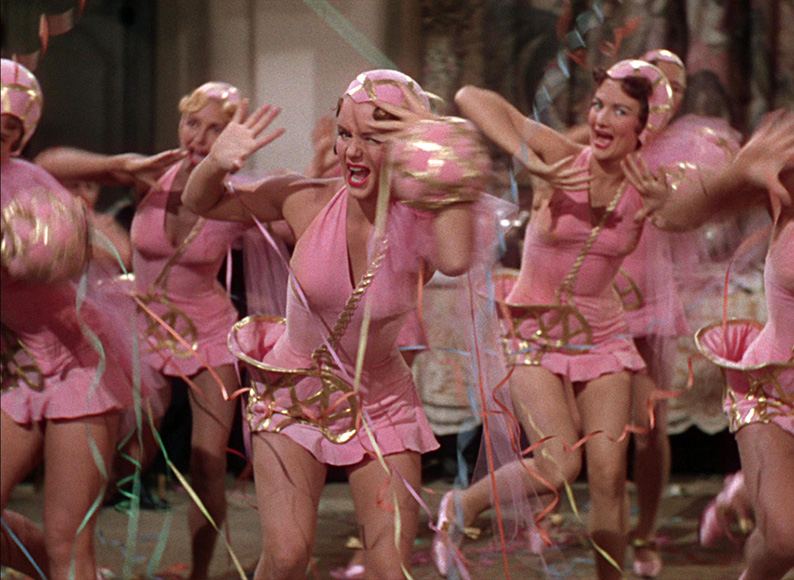
Perfect! Regular Outsider visitors may have picked up that we are not fans of perfection here. Reynold's actions were all human and perfect in this 'couldn't-be-planned-for' moment. We like imperfections in our movie diet, tell-tale signs that human beings actually created these works, small errors that creep in, gaffes that stay embedded in the effort because time and money forced the filmmakers to abandon their baby and let the world loose on it. But as I watched Singin' in the Rain last night for what must be at least the twenty-fifth time (let's not mention how many times I've listened to the songs) a part of me thought "Hollywood doesn't get much better than this." It's still funny, vibrant, dynamic, romantic, drenched in primary Technicolor colours with charismatic leads and dancing that's out of this world. The faux rivalry between Gene Kelly and Fred Astaire at the time is often brought up and I just read why that was and still seems to be the case. Here were two men who had reached a level of performance that had so outstripped any pretenders to that lofty throne, that they were the only practitioners of that degree of exemplary craft so were bound to be compared. At the cinematic dance summit were Kelly and Astaire. Everyone else was at base camp except maybe for Donald O'Connor, Kelly's fellow hoofer and movie best friend Cosmo. He must have been on the mountain somewhere. For my money, Kelly was a smoother and rounder performer and Astaire more angular but I could watch both men in action until every farmyard animal had made it safely home.
Singin' in the Rain was 'suggested' by the 1929 popular song of the same name. Some of you may know the title song from the scene of a man getting the shit kicked out of him in A Clockwork Orange (an ad lib by Malcolm McDowell that Kubrick loved and Kelly famously loathed). You may have heard the final song in the most unusual of places... In the lifeboat Narcissus, Ripley sings to herself 'You Are My Lucky Star' in petrified breaths as she takes on the titular nasty at the climax of Alien. Or you may have seen a very odd but hugely popular computer assisted commercial for the Volkswagen Beetle in 2006 featuring digitally manipulated aspects of Kelly's rain dance. However you've heard of this 68-year old movie (it feels unreal typing that incontrovertible fact), here's the skinny on the real thing. For the seventeen of you who've not seen this film, the plot is nice and simple. To say that sound changed the movies is like saying a brick changed a plate glass window. It's the late 1920s and two silent movie stars whose studio promotes them as a happy couple – which they defiantly are not – are about to have their world turned upside down. Enter synchronised sound into Hollywood. Panic. The stars' latest silent film is badly post-produced with terrible sound until someone has the great idea to make the film a musical. Stitched into this basic narrative is a rising young star, Kathy Selden who meets up with the dashing male lead, Don Lockwood and is not as charmed by him as he feels she should be. To be fair, there was a 22/21-year age gap (Reynolds turned 19 making the film).
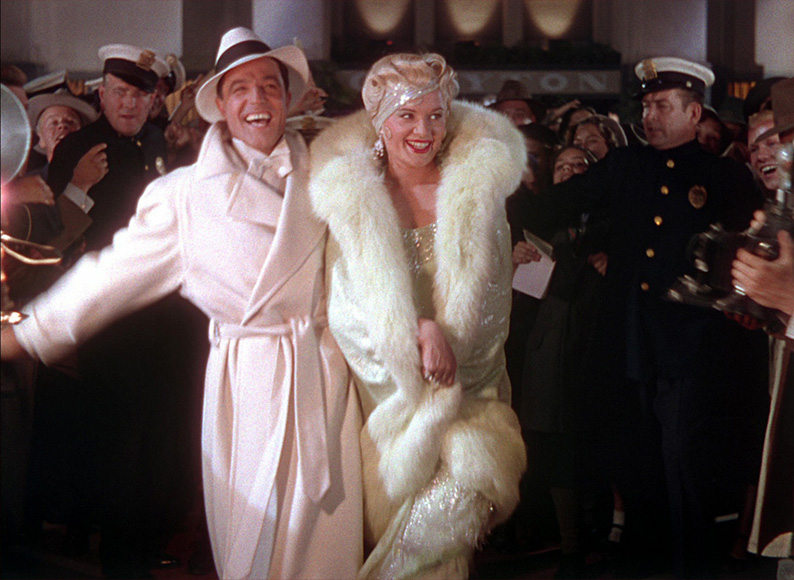
Don falls in love in the midst of potential ruin for his studio and Kathy agrees to perform the leading lady's lines and songs for her as silent star Lina Lamont has a comically harsh Brooklyn accent. Along the way are threaded an astonishing array of jubilant song and dance numbers that all advance character and narrative except for one notable exception. Once the decision is made to turn The Duelling Cavalier into The Dancing Cavalier, the historical epic becomes the dream of a Broadway hoofer. Singin' in the Rain the movie essentially stops for an astonishing 13 minutes and 14 seconds for an extended and albeit entertaining series of musical numbers with an emphasis on modern ballet. It's almost as if someone said "This movie is just too damn entertaining. Let's stop it at an hour and fifteen minutes for a long extended dance sequence..." And someone somewhere agreed with them because the ballet in Kelly's super successful An American in Paris was a big hit. I'm not saying that these dance numbers are 'wrong'. It's just that I always felt that the movie essentially paused to let Kelly get those numbers out of his system. They just don't fit unless 13 minutes and 14 seconds isn't that long to wait for the punch line of a good cinematic joke. Studio boss RF, after we've seen the dance numbers and after he's told of the boys' plan, says "I can't quite visualise it. I'll have to see it on film first..." It's quite funny but that punch line is a long time coming.
Side Note: Again, if you're a regular Outsider visitor you will know that unique frustration both Slarek and I experience when we fashion an argument or idea only to have the same thing mentioned in some detail by the complimentary material, mostly the accompanying booklets. It's only after we've finished the lion's share of the review do we go on to read our arguments back to us from another source. Well. It seems like I'm not alone when it comes to thinking the Broadway dance sequences are shoehorned in. So does co-director Stanley Donen. In his meticulously researched and therefore extremely dense BFI Classic book on the film, Peter Wollen mentions this point and then goes on to argue for its inclusion in a way I couldn't quite follow. He seems to suggest that because it's been done before, then a precedent is enough of a reason for it to be done again which seems odd to me. Never mind.
So, let's move on to the essence of the movie; communication through dance. Don't spend too much time researching the background of the film as the practicalities of making it may scuff some shine off it. Yes, there was daily exhaustion, Kelly was apparently the hardest taskmaster, multiple takes of complex one shot dance moves were required, there were bloody and bruised feet and tears shed under pianos but Fred Astaire did console Debbie Reynolds saying that her hard work would be well worth the effort. To appear effortless (I mean, there's not one drop of sweat visible on any of the dancers at any time) takes real graft. While not going so far as to demand that complete dances were done in single takes (something Astaire insisted upon in some of his films), the takes were long enough to see real dancers really dancing without any editorial 'trompes-l'oeil'. If there is a single most astonishing aspect to the craft of dancing in the film it's watching Kelly and O'Connor or all three principals move in exquisite synchronicity. I checked frame by frame the moment the two flowers pop up from Kelly's and O'Connor's violins in 'Fit as a Fiddle'. O'Connor's is a single frame, a 24th of a second before Kelly's. Class. Get this... Reynolds was something of a gymnast but had received no dance training prior to her casting. It must have felt like she had enrolled in military boot camp. Or tap shoe camp. 'Taps' was the melancholy bugle tune that was often played at military funerals and used to send soldiers to sleep. Debbie Reynolds would have related to that. It's interesting to note that the two male stars, Kelly and O'Connor were five feet, five inches and Reynolds was tiny at just under five feet two. All three are giants in my eyes.
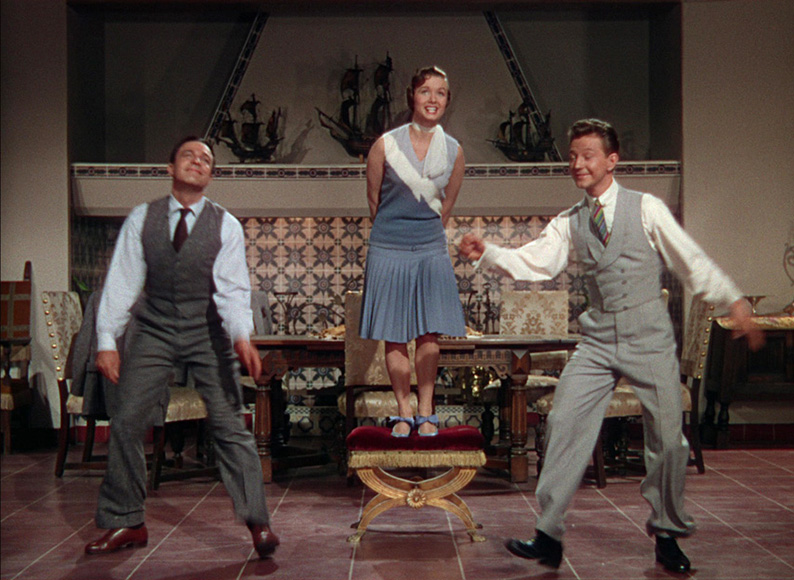
There is not a dud scene in the entire film ('Beautiful Ladies' maybe knocks on that door but it's more anachronistic than redundant) and Hollywood gets a well deserved, knowing, affectionate roasting. The art of filmmaking is exaggerated with every cliché of the craft writers Betty Comden and Adolph Green, and directors Kelly and Donen could throw at us; the exasperated director who's now stuck in the recording studio and unable to 'direct' by simply shouting instructions through a megaphone. Then there are his lion tamer trousers, a directorial quirk I believe started by Cecil B. De Mille. There are the pampered stars, the studio boss so easily impressed by those on the lower rungs beneath him. Then there's the lovely idea, perhaps even true, that in the silent filmmaking days, movies would shoot under the same studio roof, right next to each other. Roll 'em! There's a classic 'Texas switch' which nudges into 'meta' territory. Kelly volunteers to be the stuntman and is then replaced by a real stuntman. He pops up from behind the bar feigning wooziness from the faux impact he's just (not) experienced. Let's not even go into the actual voice replacement roster. Oh, go on then. In the movie Lina Lamont (Jean Hagen) has a terrible accent. Kathy Selden (Debbie Reynolds) dubs her. In reality Jean Hagen's normal voice is not wide Brooklynese. In fact, she dubs herself in the film within the film. When Kathy is singing as Lina, it's not Debbie Reynolds at all. It's sung by Betty Noyes and what an unfortunate surname for a singer that is. Reynolds sings all the other songs though. Age and context cannot fault the songs and the dancing. Like Mama Mia (where could I be going with this?) Singin' in the Rain was conceived as a film to showcase pre-recorded songs. Only 'Make 'Em Laugh' was written for the movie (shamelessly ripping off 'Be A Clown' by Cole Porter for The Pirate) but the actual story was a secondary consideration. This was also true for The Lost World: Jurassic Park whose story was simply the string that attached sequences worked out well in advance of any narrative. And in that film's case, it really shows. Here, screenwriters Green and Comden knocked it out of the park.
I'll finish with a celebration of three dance sequences. I already mentioned the synchronicity so we'll take that hugely difficult thing and take it (deep breath) for granted.
(1) 'Fit as a Fiddle': In the 'unreliable narrator' flashback to the younger Kelly and O'Connor plying their trade, there is a moment at which both men bend their legs taking their bodies down low as if sitting on invisible bricks. They then play their violins while, Russian dance style, their alternate legs shoot forward... for twelve beats. Do you know how hard that is? That's a level of fitness not many of us have ever reached. O'Connor mentions on the commentary that his leading leg was his right one. So was Kelly's so this is one of the many reasons how the two could dance so beautifully together. Can you even begin to believe that O'Connor was on four packs of cigarettes a day!?
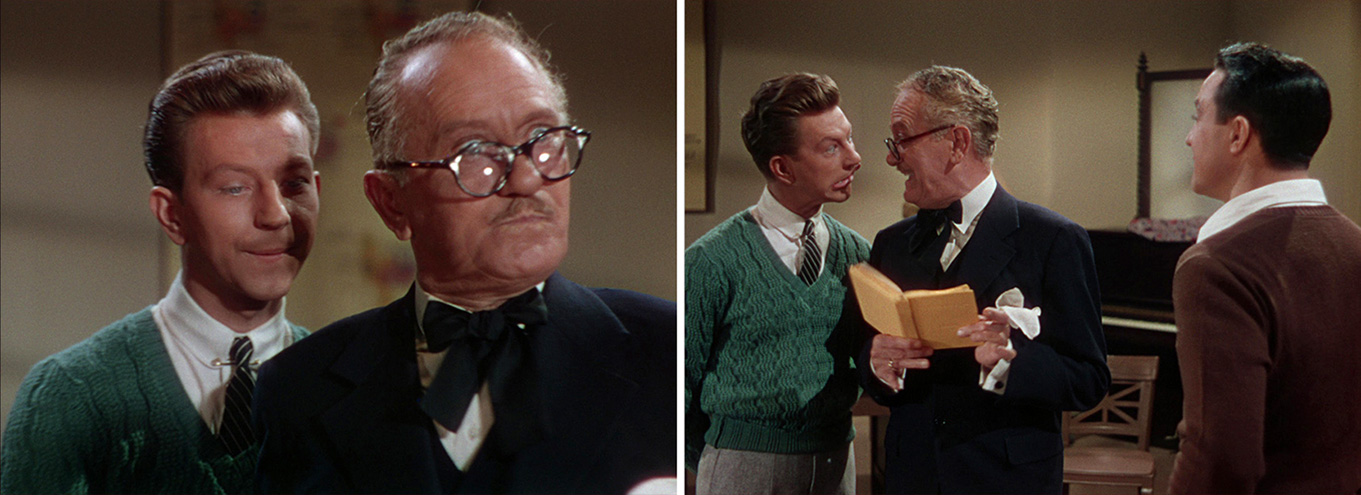
An alarming cut
(2) 'Moses': There is an exuberance and playfulness at the heart of 'Moses', clearly my favourite song in the movie. There is also an alarming cut at 48' 15". (Cosmo makes faces behind the elocutionist's back, stops when he's looked at and the elocutionist looks back at Kelly. But we then cut to the last few seconds of the action of the previous shot of Cosmo making faces). Ouch. But the dancing... If you examine the editing of the dances, you'll see that they were almost pre-edited. There is no cheating, no cutting for a breather. While on the subject of the editing, there is a completely mysterious jump cut at 1 hour, 22 minutes and 4 seconds at the end of the Cyd Charisse Green Dress dance. This points to some error in post. It's not the cut any editor would make. Was there negative damage? 'Moses' is the sort of dance number that may tempt anyone into giving tap a go. It's high on my list of 'should have, could have, would have,' things to do. I guess you're never too old...
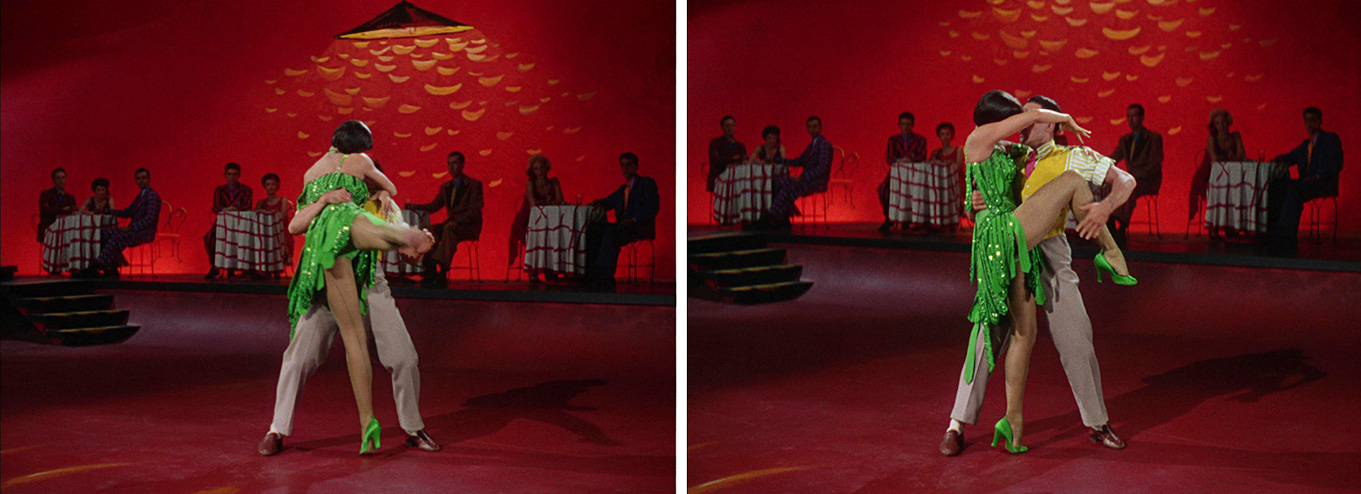
Negative damage?
Now by saying my number (3) is 'Good Mornin', I am missing a very obvious choice. Let me explain why... 'Singin' in the Rain' is a fabulous sequence. It's one that personifies the joys of being in love and seeing a rosy path ahead. We've all been that happy and maybe we've all danced when we've been that happy but technically, to me, it's not as complex or demanding as any of the other dances. It's Kelly just behaving like a child (a gifted and acrobatic child) because he's so happy. That's lovely but the number previous to it knocks its socks off in execution, complexity and talent for me.
(3) 'Good Mornin': Kelly and Donen were always wary of the songs just crashing in without a smooth segue from dialogue scene to song/dance. This one follows from Kathy and Cosmo's brilliant idea to turn the flop into a potential musical hit. The background music takes flight as Don realises this is 'his lucky day'. Cosmo corrects him. It's the next day... "It's one-thirty in the morning!" "And what a lovely morning!" It's a gentle, soft merge into the song and not only is the actual song simple and catchy, it inspires an insanity of complexity with the three principals syncing up and down stairs and always moving to the left of frame while the camera tracks their progress. We only cut on new set ups and natural pauses and in 'Good Mornin'' the one thing you simply do not notice is how huge the 'house' is in which they're dancing. And then two things occur to you. You're looking at a movie set and besides, movie stars were paid so much they could afford such expensive homes. Seeing places this large really makes me feel for those poor souls who are on lockdown in a small dwelling with no access to greenery and heaven help them, looking after small children. Stay safe. Stay sane.
Singin' in the Rain is absurdly lovely. Frothy, fresh, full of beans and brimming with joyous vitality, it has energy pouring out of its sprockets. It's pretty much perfect for shut-ins. I can forgive a few dodgy edits, the motorcycle dummy, the mangling pronunciation of 'Monsieur' and the kissing Kelly who seems to have taught Roger Moore how to perfect the lust free closed mouth smooch. Highly and excitedly recommended.
Considering the original nitrate three-strip Technicolor negative was lost in a fire in 1978 (the cinematic equivalent of losing the Sistine Chapel but it's OK, we have hi-res photos of it...), it's a miracle the film is looking this good. For details of the movie's travails and rebirth, see here.*** So we are looking at a digital restoration of second and fourth generation fine grain film stocks and the results, shot in the 1.37:1 aspect ratio, are truly astonishing. It has a vibrancy that almost pulses and for such a delightful film, there are not too many dark areas to lose detail in. The original mono sound has been given a very subtle 5.1 surround makeover obviously without modern dynamic range or too much for the sub to be bothered with but for a film this old, it sounds wonderful; no high end hiss and a fine, rounded lower end. It's just terrific.
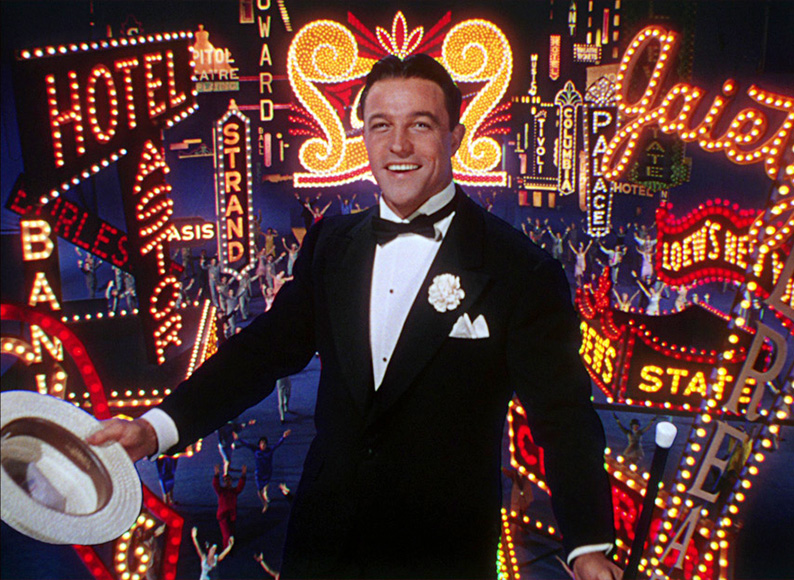
There are several spoken languages aside from English; French, German, Italian, Spanish x 2, Portuguese, Czech and Polish. There are also subtitles for the hearing impaired in the above languages and many more. As they are listed in their own language, I'll be lazy and let you choose what you need from this lot: English, French, German, Italian, Spanish x 2, Portuguese, Czech, Danish, Finnish, Hungarian, Norwegian, Polish, Russian and Swedish.
Audio Commentary featuring (deep breath) Debbie Reynolds, Donald O'Connor, Cyd Charisse, co-director Stanley Donen, writers Adolph Comden & Betty Green, actress Kathleen Freeman, director Baz Luhrmann, and film historian Rudy Behlmer. Phew.
As others have pointed out, Debbie Reynolds is merely the M.C. for the commentary track and that is almost tragic. One of the three stars of the movie is just introducing the participants? It can't be that the leading lady hasn't a single story to tell? Is there only one reason for her meagre and suspiciously scripted participation? Did she have such an awful time making it that she felt she couldn't sugar-coat the experience? We'll never know. She died a day after her daughter, Carrie Fisher, in 2016. The commentary is extremely enlightening with each participant giving her/his money's worth. I just would have preferred to hear Debbie Reynolds' side of the story... I'll leave you with my favourite contribution from O'Connor said in the spirit of thankfulness being part of cinema history... "Thank goodness I was in it!"
Singin' in the Rain: Raining on a New Generation (50' 46")
This documentary features contemporary (well, 2011) musical figures such as Matthew Morrison, Paula Abdul, Rob Marshall, Adam Shankman, Usher, and Baz Luhrmann, among others. They all have a lot to say about the importance of the film and as Glee was big on TV then, we get a lot from the show's talented performers and choreographers on the influence of the film on their own work. Let's just use the words 'extraordinarily significant' and leave it at that. It's entertaining enough with the clips from the film sourced from a less than pristine copy. I believe this extra and the commentary has been ported from an earlier DVD release.
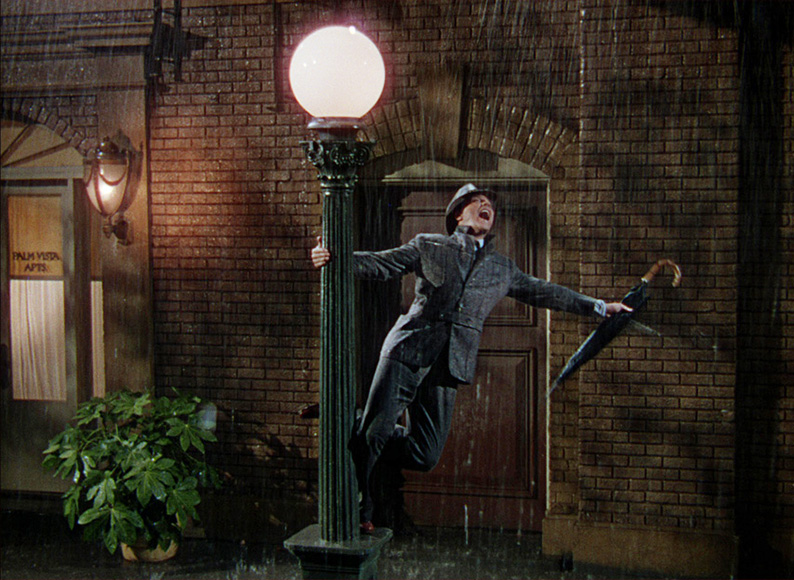
Jukebox
Also ported is this feature that lets you access any of the musical numbers with a click. For someone who's worn both the vinyl and the CD out, I really don't need this feature.
Theatrical Trailer (4' 07")
This one's an oddity. Yes, all the hyperbolic textual palaver is in place but after a full scene of RF shutting the studio down to prep for talking pictures, it seems to go out of its way to give away its piecemeal origin by naming all the songs with relevant excerpts. And then it hypes the Broadway ballet, present simply because of the success of An American in Paris. It was like Disney hiring Lebo over and over just in case it was his voice that made The Lion King such a hit...
Singin' in the Rain is the quintessential and nearest-to-perfect Hollywood musical of all time made when the wane of the genre's popularity was just starting. It is a feast for the senses and an optimistic, gentle delight. Its reputation has not only grown over time, it's now a regular on Top Ten of All Time lists notably Sight and Sound's and as a lovely story in and of itself, I quote Gene Kelly in London for Queen Elizabeth's coronation in 1953 excerpted from the afore mentioned BFI Classic:
"Suddenly over the loudspeaker system, a man who had been keeping everyone informed about what was happening said "Ladies and gentlemen, I'd like you all to join Gene Kelly in 'Singin' in the Rain' and on came the record. A few seconds later, thousands of lovely, cold, wet, shivering English men and women started to sing. It was the biggest thrill of my life. It beats anything I've ever known - the opening of Pal Joey, my Academy award, you name it. It was a once-in-a-lifetime experience, and I felt if I never achieved another thing - which was the way things seemed to be going - I'd have justified my existence. Suddenly the English could do no wrong.
Neither could this movie.
|